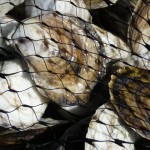Unique partnership among a university, a church and companies makes a difference for unemployed veterans in Newark It was a proud moment at the Willing Heart Community Care Center in Newark, NJ, on March 3, where 12 local veterans graduated as the inaugural class of the Rutgers Veterans Environmental Technology and Solutions (VETS) program. […]
Fisheries/Aquaculture
Human Activity is Leading to a “Major Extinction Event” for Sea Life, Scientists Say
Though previously thought to be impervious due to its massive size, the collective of the world’s oceans may be on the verge of a wide-scale extinction event, according to a new study. Scientists from the University of California, Santa Barbara, (UCSB) warn that, if human activity continues on its current trajectory, we could be seeing a whole lot more sea animal deaths, and possibly collapses of entire oceanic ecosystems… “We’re lucky in many ways,” said Dr. Malin L. Pinsky, a marine biologist at Rutgers University and one of the authors of the new report. “The impacts are accelerating, but they’re not so bad we can’t reverse them.”… Drs. Pinsky and McCauley tried to gain a better understanding of all this by collecting data from a wide range of sources, including discoveries logged in the fossil record and statistics on modern-day shipping activities, fish catches and seabed mining. What they found is that there’s still time to make things right.
RU Survey: Summer Classes at Shore Would be Popular
Rutgers University-New Brunswicks Summer Session, with more than 2,200 course sections, already one of the nations largest summer programs, is adding a new component with 17 courses at the Jersey Shore… The decision to establish RU at the Shore for 2…
Delaware Estuary Summit Charts Course for Aquaculture in the Region
Managers, educators, and oyster farmers gathered at Cape May’s Grand Hotel late last month for a special session, “Shellfish Culture Now and Tomorrow: Charting a Course for Delaware Estuary Aquaculture,” held in conjunction with the Delaware Estuary Science and Environmental Summit. The Partnership for the Delaware Estuary has hosted the summit every two years since […]
Climate May Have Fluke on the Move
Like every other living organism, fish just want to be comfortable. That’s why, in the face of warming ocean water, they may be on the move. Dr. Malin Pinsky of Rutgers University, who studies the effects of climate change in fisheries, said many species are shifting to the north at a time when the climate has been warming… “We’re seeing a climate fingerprint in many of these shifts in species distribution,” Dr. Pinsky said… Dr. Pinsky and Rutgers have just begun a joint research project with Stony Brook University, George Mason University and the University of North Carolina to understand whether a changing climate played a role in the shift and what the economic and regulatory impacts will be.
EPA Considering Hackensack River for Cleanup Plan
In an acknowledgment that the Hackensack River remains seriously polluted with a century of industrial waste, the federal government will consider adding the river to the federal Superfund list, a program reserved for the country’s most contaminated sites… In addition, research conducted by Rutgers’ Judith Weiss over the past decade has showed that the mercury and PCBs in the Hackensack’s sediment are still so high that crabs and bluefish exhibit extremely odd behavior, making it hard for them to catch prey… “Are there environmental impairments in the Hackensack? I believe there are,” said Beth Ravit, the Rutgers University professor in charge of the study on the use of oysters to clean up the river.
Spotlight on Rutgers’ Oyster Research at Cape May Canal Draws Industry Out of Shell
What looks like a water-purification business to many people transiting the Cape May Canal by boat is actually a research facility. David Jones, laboratory researcher and the Aquaculture Innovation Center operations manager, said he doesn’t think many people know about the Rutgers University facility or its scope of operations… The food that Rutgers AIC is not-so-secretly developing is oysters… “Rather than traditional fishermen that are harvesting wild oysters from the bay, the oysters grown in the lower (Delaware) Bay use a containerized system,” said Lisa Calvo, Aquaculture Extension program coordinator. “They all go pretty much to a half-shell market, a more specialty niche market of high-end restaurants and better markets for eating raw on the half shell.”
The Oceans Are on the Verge of Mass Extinction. Here’s How to Avoid It.
We land-based creatures live in the midst of a massive extinction crisis, just the sixth one over the past half billion years. What about the oceans?… Now, as tricky as it will be to cut back on overfishing by convincing fish farmers to mend their ways and consumers to change their habits, the even bigger challenge will be to stop trashing the place all of these critters call home. Habitat degradation, according to the Science authors, is the main trigger for the extinction wave we’re now seeing on land, and is probably the biggest threat to cause a similar catastrophe at sea. “If you cranked up the aquarium heater and dumped some acid in the water, your fish would not be very happy,” Malin L. Pinsky, a marine biologist at Rutgers University and an author of the report, told The Times’ Zimmer.
Red Knot Protection Could Take Toll on Oyster Industry, Beach Replenishment
A recent decision by the federal government to list a migratory shorebird as a threatened species could have implications beyond the Delaware Bay beaches where the birds come each spring to feed on horseshoe crab eggs.. While wild oyster harvesting began locally in the 1730s, using the tidal flats to grow them, a French method known as “rack-and-bag” is relatively new… “There are nine growers on the Delaware Bay, though one is not active, and they grow 1.5 million oysters a year,” said Lisa Calvo, aquaculture program coordinator with New Jersey Sea Grant at Rutgers University.
Global Warming Led River, Ocean to Meet, Form Delaware Bay
At the height of the last ice age 20,000 years ago, the Delaware Bay did not exist. Then a warming trend, which continues to this day, joined the ancestral Delaware River with the ocean to create today’s Delaware Estuary. An estuary is a tidally flooded river valley. But 20,000 years ago, there were no tides yet to form it… “The ocean was 60 to 90 miles off the coast. Sea levels were about 390 feet lower back then,” said Kenneth Miller, a marine geologist at Rutgers University.



